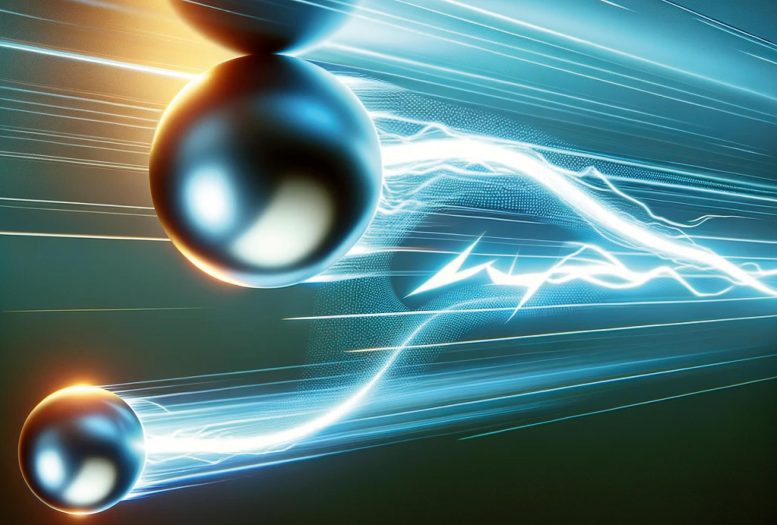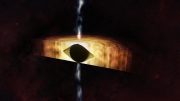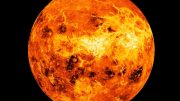
Electrons whizzing through the kagome metal Fe3Sn2 are influenced by the proximity of a flat band (shown by the reflection of the top ball on a flat surface). This causes the electronic charge to be fractionalized, or split (shown here by the appearance of the lower ball). Researchers have now observed this effect spectroscopically. Credit: Paul Scherrer Institute / Sandy Ekahana
Quantum mechanics tells us that the fundamental unit of charge is unbreakable – but exceptions exist.
A research team led by the Paul Scherrer Institute has spectroscopically observed fractionalization of electronic charge in an iron-based metallic ferromagnet. Experimental observation of the phenomenon is not only of fundamental importance. Since it appears in an alloy of common metals at accessible temperatures, it holds potential for future exploitation in electronic devices. The discovery is published in the journal Nature.
Basic quantum mechanics tells us that the fundamental unit of charge is unbreakable: the electron charge is quantized. Yet, we have come to understand that exceptions exist. In some situations, electrons arrange themselves collectively as if they were split into independent entities, each possessing a fraction of the charge.
The fact that charge can be fractionalised is not new: it has been observed experimentally since the early 1980s with the Fractional Quantum Hall Effect. In this, the conductance of a system in which electrons are confined to a two-dimensional plane is observed to be quantized in fractional – rather than integer – units of charge.
The Hall Effect provides an indirect measure of charge fractionalization, through a macroscopic manifestation of the phenomenon: the voltage. As such, it does not reveal the microscopic behavior – the dynamics – of fractional charges. The research team, a collaboration between institutions in Switzerland and China, has now revealed such dynamics via spectroscopy of electrons emitted from a ferromagnet when illuminated by a laser.
Pushing the Electrons to Strange Behavior
To fractionalise charges, you need to take electrons to a strange place where they stop following normal rules. In conventional metals, electrons typically move through the material, generally ignoring each other apart from the occasional bump. They possess a range of different energies. The energy levels in which they lie are described as “dispersive bands”, where the kinetic energy of the electrons depends on their momenta.
In some materials, certain extreme conditions can push electrons to start interacting and behaving collectively. Flat bands are regions in the electronic structure of a material where the electrons all lie in the same energy state, i.e., where they have nearly infinite effective masses. Here, electrons are too heavy to escape each other and strong interactions between electrons reign. Rare and sought after, flat bands can lead to phenomena including exotic forms of magnetism or topological phases such as fractional quantum Hall states.
To observe the Fractional Quantum Hall Effect, strong magnetic fields and very low temperatures are applied, which suppress the kinetic energy of electrons and promote strong interactions and collective behavior.
The research team could achieve this in a different way, without application of a strong magnetic field: by creating a lattice structure that reduces electron kinetic energies and allows them to interact. Such a lattice is the Japanese woven bamboo “kagome” mat, which characterizes atomic layers in a surprisingly large number of chemical compounds. They made their discovery in Fe3Sn2, a compound consisting only of the common elements iron (Fe) and tin (Sn) assembled according to the kagome pattern of corner sharing triangles.
Laser ARPES Allows a Closer Look
The researchers did not set out to observe charge fractionalization in kagome Fe3Sn2. Instead, they were simply interested in verifying whether flat bands existed as predicted for this ferromagnetic material.
Using laser angle resolved photoemission spectroscopy (laser ARPES) at the University of Geneva with a very small beam diameter, they could probe the local electronic structure of the material at an unprecedented resolution.
“The band structure in kagome Fe3Sn2 is different depending on which ferromagnetic domain you are probing. We were interested to see whether, using the micro-focused beam, we could detect inhomogeneities in the electronic structure correlated to domains that had been previously missed,” says Sandy Ekahana, postdoctoral fellow in the Quantum Technology group at PSI and first author of the study.
Electron Pockets and Colliding Bands
Focusing on certain crystal domains, the team identified a feature known as electron pockets. These are regions in the momentum space of a material’s electronic band structure where the energy of electrons is at a minimum, effectively forming pockets where electrons ‘hang out’. Here, the electrons behave as collective excitations, or quasiparticles.
On examining these closely, the researchers detected strange features in the electronic band structure that were not fully explained by theory. The laser ARPES measurements revealed a dispersive band, which did not match with density functional theory (DFT) calculations – one of the most established methods to study electron interactions and behaviors in materials. “It quite often happens that DFT doesn’t quite match. But from an experimental point of view alone, this band was extremely peculiar. It was extremely sharp, but then it suddenly cut off. This is not normal – usually bands are continuous,” explains Yona Soh, scientist at PSI and corresponding author of the study.
The researchers realized that they were observing a dispersive band interacting with a flat band, predicted to exist by colleagues from EPFL. The observation of a flat band interacting with a dispersive band is itself of deep interest: It is believed that the interaction between flat and dispersive bands allows new phases of matter to emerge, such as “marginal” metals where electrons do not travel much further than their quantum wavelength and peculiar superconductors.
“There has been a lot of theoretical discussion about the interaction between flat and dispersive bands, but this is the first time that a new band caused by this interaction has been discovered spectroscopically,” says Soh.
Weird Electron Behavior Gets Even Weirder: Fractionalization of Charge
The consequences of this observation are even more profound. Where the two bands meet, they hybridize to make a new band. The original dispersive band is occupied. The flat band is unoccupied as it lies above the Fermi level – a concept that describes the cutoff between occupied and unoccupied energy levels. When the new band is created, the charge is split between the original dispersive band and the new band. This means that each band contains only a fraction of the charge.
In this way, the measurements by Ekahana and colleagues provide direct spectroscopic observation of charge fractionalization.
“Achieving and observing states in which charge is fractionalised is exciting not only from the perspective of fundamental research,” says Gabriel Aeppli, head of the photon science division at PSI and professor at EPFL and ETH Zurich, who proposed the study. “We observe this in an alloy of common metals at low, but still relatively accessible temperatures. This makes it worthwhile considering whether there are electronic devices that might exploit fractionalization.”
Reference: “Anomalous electrons in a metallic kagome ferromagnet” by Sandy Adhitia Ekahana, Y. Soh, Anna Tamai, Daniel Gosálbez-Martínez, Mengyu Yao, Andrew Hunter, Wenhui Fan, Yihao Wang, Junbo Li, Armin Kleibert, C. A. F. Vaz, Junzhang Ma, Hyungjun Lee, Yimin Xiong, Oleg V. Yazyev, Felix Baumberger, Ming Shi and G. Aeppli, 6 March 2024, Nature.
DOI: 10.1038/s41586-024-07085-w









Please comment on the following two dialogues:
Roy Stewart, Tesseract Research | March 3, 2024 at 8:53 am | Reply
The SM is overly complex due to a wide-spread misapprehension of the usefulness of the maths. Mathematical formulations are highly regarded, rightfully, however it is generally forgotten that the maths are very plastic, several self-consistent sets of equations may be contrived to explain the same phenomenon, Lakeoff and Nunez rightly point out that all maths are mapping functions – maps pare not necessarily reality. The universe does not do math, the universe IS geometry, therefore mathematics is at a twice remove from reality.
Bao-hua ZHANG | March 3, 2024 at 6:08 pm | Reply
Very good! The universe does not do math (formula or fraction), the universe IS geometry.
The branch of geometry (mathematics) known as topology has become a cornerstone of modern physics. Topological vortex and antivortex are two bidirectional coupled continuous chaotic systems. They exhibit parity conservation, charge conjugation, and time reversal symmetry. The synchronization effect is extremely important in their interactions. The synchronization effect of the superposition, deflection, and twisting of multiple or countless topological vortices will make spacetime motion more complex.
Spin is a natural property of topological vortices. The perpetually swirling topological vortices defy traditional physics’ expectations. Spin is synchronized with energy, spin is synchronized with gravity, spin is synchronized with time, spin is synchronized with evolution. Please answer:
What is the difference between topological vortices and perpetual motion machines?
If you are interested, you can browse https://zhuanlan.zhihu.com/p/463666584 and https://zhuanlan.zhihu.com/p/390071860.
Friendly link,
https://scitechdaily.com/scientists-demonstrate-effective-fusion-spark-plug-in-groundbreaking-experiments/.